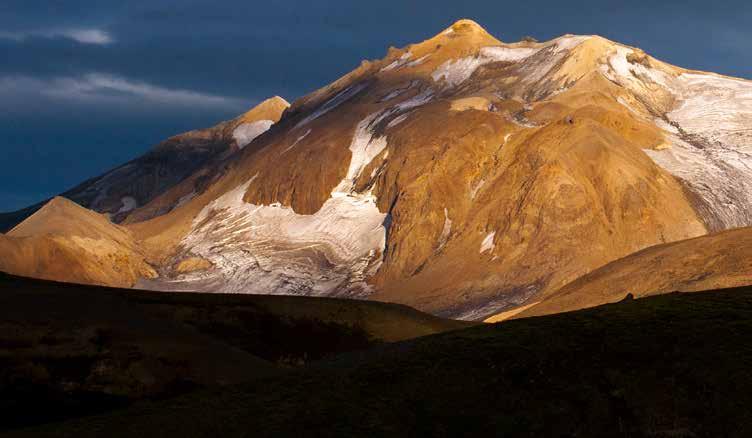
4 minute read
Árbær Open Air Museum
Step back into past while exploring these historic buildings
Reykjavík City Museum was founded in 2014 when The Settlement Exhibition, Reykjavik Maritime Museum, Reykjavik Museum of Photography, Viðey Island and Árbær Open Air Museum were combined into one museum.
Árbær was a traditional farm on a hill just east of Elliðaá River. Through the centuries, it was a resting place to and from the entire Seltjarnarnes Peninsula, including Reykjavík. The last inhabitants of Árbær left in 1948, and nine years later, the Reykjavík town council agreed to rebuild the farm. It was decided that a collection of culturally important houses would also get a home there. There are over twenty buildings in the museum today, most of them from Reykjavík’s centre. The first house to be moved to Árbær Open Air Museum was Hansen’s House, named after merchant Símon Hansen, who built it at Pósthússtræti 15, just east of Reykjavík Cathedral in 1823. The house represents the oldest type of half-timbered House in Reykjavík. Many renowned people lived in the house, such as Jón Árnason, a collector of folklore, Sigurður Guðmundsson, Iceland’s first painter, and photographer Sigfús Eymundsson. Sigfús was a pioneer in photography in Iceland, a bookseller, and an enthusiastic seller of one-way trips to North America.
The Árbær Open Air museum is a fun and lively museum. Guðbrandur Benediktsson is the director of Reykjavík City Museum.
Hansen’s House, the first house to be moved to the museum in 1960, was originally built at Pósthússtræti 15 in 1823 It is not difficult to find your way around Árbær Open Air Museum


The original Árbær farm

Árbær Open Air Museum is popular among tourists Árbær Open Air Museum.and the church of Árbær, Kópavogur can be seen in the distance

THE CATHOLIC CHURCH IN REYKJAVÍK
The Cathedral of Christ the King, Landakotskirkja, stands at the top of Landakotshæðinn in the western part of Reykjavík.
The National Church of Iceland is Lutheran, with 70% of Icelanders registered in it. The history of Christianity is as old as the settlement in the country, but Icelanders converted to Christianity (Roman Catholicism) in the Alþingi of 1000. The Reformation took place here in 1550 after Jón Arason, bishop of Hólar in Hjaltadalur, was beheaded in 1550, along with his sons. The first Catholic priest since the Reformation, the Frenchman, Bernard, came here around 1860, bought the Landakot cottage on the outskirts of Reykjavík and built a small chapel near the town in 1864. After the First World War, Catholics in Iceland began to discuss building a new and larger church. The architect Guðjón Samúelsson was commissioned to design a church in the neo-Gothic style. When the church was consecrated in July 1929, it was the largest church in the country. Guðjón designed many historic buildings in the capital, including the Lutheran Hallgrímskirkja, the largest church in the country at the top of Skólavörðuholt.

REYKJAVÍK REYKJAVÍK
A workplace like the Boatyard in Reykjavíkurhöfn (Reykjavík harbour) is a lively spot in the middle of the city.

Looking north up Bergstaðastræti towards Skólavörðustígur.

THE CHARMING ÞINGHOLT
Þingholt is a neighbourhood in the centre of Reykjavík. Bergstaðastræti can be called its main artery. The street extends from Landspítali University Hospital by Barónsstígur to Laugavegur, the primary and oldest shopping street in Reykjavík. Hotel Holt, one of the more luxurious and older hotels in the country, noted for its art collection, is on this street. The Kaffibarinn bar is on the street, too. It has been one of the most popular bars in the country for the last 25 years. The Gandhi Indian restaurant is there also, where you can even buy Greenland beer. LIVELY REYKJAVÍK HARBOUR
Iceland is the 19th largest fishing nation globally and number three in Europe, after Russia and Norway. In terms of per capita, it is by far the largest in the world, after the Faroe Islands, as the country catch measures just over a million tonnes of fish a year. The stern trawler Bergur VE 44 (pictured) was built in Denmark 23 years ago and arrived in the Westman Islands from Norway 6 years ago. Bergur is 36 metres long and 569 GT (Gross ton) in size. It was being repaired in the boatyard in Reykjavík recently. Vísir, the Grindavík fishing company, bought the trawler from the Westman Islands, to be delivered to the company shortly. Forty-six trawlers fish around Iceland, but they are by far the largest fishing vessels fishing in the Icelandic fishing jurisdiction. There are 649 other fishing vessels, according to Statistics Iceland.










